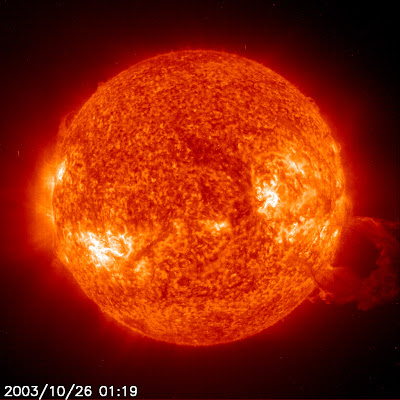.

Over a month ago I wrote the following article in the CPT outlining in detail how solar radiation and other frequencies bombarding the Earth could be responsible for the Toyota recall problems. I said it was an issue that should be investigated. I sent the article to Toyota but obviously others have jumped into the search and now it appears the
National Highway Traffic Safety Agency is opening a formal investigation of this issue.
Coltons Point TimesThursday, February 11, 2010
What is Really Causing the Auto Recalls? Maybe it wasn't Toyota's Fault?You heard it first on the CPT and this is what is now being said by others in the media.
 US News and World ReportCosmic Rays may be Causing Unintended Acceleration in Toyotas
US News and World ReportCosmic Rays may be Causing Unintended Acceleration in ToyotasPosted: Mar. 17, 2010 10:03 a.m.
Like a story line straight out of a George Lucas film, reports are surfacing that cosmic rays may be responsible for the dangerous cases of unintended acceleration that have spurred the recall of millions of Toyota vehicles.
“Before you dismiss the cosmic ray theory, consider that the issue has been known since the 1950s, and airplane and spacecraft manufacturers design in safeguards that triple-check all data as a defense from such interference from space,” writes Autoblog. “Later, in the 1970s, researchers found that small amounts of this radiation does indeed make it down to the surface and can cause problems with small electronics like cell phones and computers.”
The possibility was brought to light by a “concerned scientist” who sent an email to the National Highway Traffic Administration (NHTSA). The message, which is published in full on Jalopnik, reads: “For reasons I am unable to disclose, I am anonymously submitting several publically available scientific papers that discuss the possibility of cosmic rays disrupting electronics at sea level, essentially flipping a bit from one to zero, or vice versa. This phenomenon is a ‘soft’ error that is not detectable except through redundant electronic and communication systems. The scientific community refers to such occurrences as ‘Single Event Upsets,’ or SEUs.” The scientist goes on to state, “The reason SEUs are now relevant to the automotive industry is because electronics have gotten smaller and the required voltage levels have dropped significantly, therefore making electronics more susceptible to cosmic radiation…”
Toyota, however, denies that SEUs are to blame for reported cases of unintended acceleration. According to the Detroit Free Press: “Toyota staunchly defends its electronics, saying they were designed for ‘absolute reliability.’ Responding to the Free Press, Toyota said its systems ‘are not the same as typical consumer electronics. The durability, size, susceptibility and specifications of the automotive electronics make them robust against this type of interference.’”
Still, the NHTSA is taking the tip seriously -- adding the anonymous email to its investigation case file.
Check out the latest Toyota recall news and information, including how the company's recent troubles affect our rankings. If you're in the market for a new car, check out the U.S. News rankings of this year's best cars as well as this month's best car deals.
 Detroit Free Pess
Detroit Free PessMarch 16, 2010
Are cosmic rays really causing Toyota's woes?
Regulators take closer look at design of electronicsBY JUSTIN HYDE
FREE PRESS WASHINGTON STAFF
WASHINGTON -- It may sound far-fetched, but federal regulators are studying whether sudden acceleration in Toyotas is linked to cosmic rays.
Radiation from space long has affected airplanes and spacecraft, and is known for triggering errors in computer systems, but has received scant attention in the auto industry.
The questions show how deep regulators and automakers may have to dig to solve the mysteries of sudden acceleration. Toyota says it is fixing mechanical problems -- floor mats and sticky pedals -- that explain sudden acceleration in 13 models and 5.6 million vehicles.
But at least half of more than 1,500 recent complaints to regulators involve other models, raising questions whether Toyota has fixed its problem.
An anonymous tipster whose complaint prompted regulators to look at the issue said the design of Toyota's microprocessors, memory chips and software could make them more vulnerable than those of other automakers.
"I think it could be a real issue with Toyota," Sung Chung, who runs a California testing firm, said.
Toyota, which has led the auto industry in using electronic controls, told the Free Press its engine controls are "robust against this type of interference."
Cosmic rays offered as acceleration cause
Electronics makers have known for decades about "single event upsets," computer errors from radiation created when cosmic rays strike the atmosphere.
With more than 3,000 complaints to U.S. regulators of random sudden acceleration problems in Toyota models, several researchers say single event upsets deserve a close look.
The phenomenon can trigger software crashes that come and go without a trace. Unlike interference from radio waves, there's no way to physically block particles; such errors typically have to be prevented by a combination of software and hardware design.
And an anonymous tipster told NHTSA last month that "the automotive industry has yet to truly anticipate SEUs."
Such radiation "occurs virtually anywhere," said William Price, who spent 20 years at the Jet Propulsion Lab testing for radiation effects on electronics. "It doesn't happen in a certain locale like you would expect in an electromagnetic problem from a radio tower or something else."
Toyota staunchly defends its electronics, saying they were designed for "absolute reliability." Responding to the Free Press, Toyota said its systems "are not the same as typical consumer electronics. The durability, size, susceptibility and specifications of the automotive electronics make them robust against this type of interference."
Testing for the problem would involve putting vehicles in front of a particle accelerator and showering them with radiation, a step that experts said would help resolve the question.
"Nobody wants to come out and say we have issues and we need to test," said Sung Chung, president of the testing firm Eigenix.
The phenomenon was first noted in the 1950s affecting electronics at high altitudes; unlike electromagnetic waves, there are no ways to physically shield circuits from such particles. Airplane and spacecraft makers have long designed their electronics with such radiation in mind, through safeguards such as systems that triple-check data.
Only in the late 1970s did researchers discover that a minuscule portion of such radiation falls to earth. It's not enough to harm humans, but as circuits in computers and cell phones on the ground have shrunk to the width of several dozen atoms, the risk of errors has grown. "Five years ago, it was a problem in very few applications," said Olivier Lauzeral, general manager of IRoC Technologies, which tests chips and software for SEU resistance. "In the past couple of years, we've seen a rise in demand and interest."
In an anonymous e-mail last month to the National Highway Traffic Safety Administration, a tipster said such an error "may be one reasonable explanation for incidents of sudden acceleration," adding that the automotive industry had yet to adapt the techniques used by aircraft firms to prevent problems from SEUs.
NHTSA added the tipster's information to its electronic investigative file on Toyota recalls. The agency declined several requests from the Free Press for comment.
Electronic throttle controls like the ones under scrutiny in Toyotas are widespread in the industry. They're more reliable than mechanical links, they save weight and space, and make other technology, like stability control, possible.

































